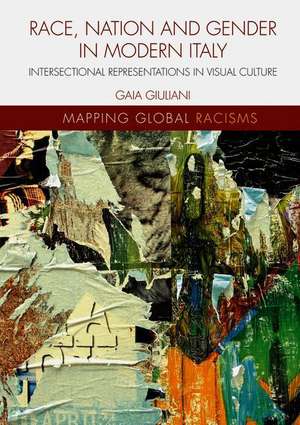Race, Nation and Gender in Modern Italy: Intersectional Representations in Visual Culture: Mapping Global Racisms
Autor Gaia Giulianien Limba Engleză Hardback – 11 iun 2018
This book explores intersectional constructions of race and whiteness in modern and contemporary Italy. It contributes to transnational and interdisciplinary reflections on these issues through an analysis of political debates and social practices, focusing in particular on visual materials from the unification of Italy (1861) to the present day. Giuliani draws attention to rearticulations of the transnationally constructed Italian ‘colonial archive’ in Italian racialised identity-politics and cultural racisms across processes of nation building, emigration, colonial expansion, and the construction of the first post-fascist Italian society. The author considers the ‘figures of race’ peopling the Italian colonial archive as composing past and present ideas and representations of (white) Italianness and racialised/gendered Otherness.
Students and scholars across a range of disciplines, including Italian studies, political philosophy, sociology, history, visual and cultural studies, race and whiteness studies and gender studies, will find this book of interest.
Preț: 700.75 lei
Preț vechi: 824.41 lei
-15% Nou
Puncte Express: 1051
Preț estimativ în valută:
134.13€ • 145.75$ • 112.74£
134.13€ • 145.75$ • 112.74£
Carte tipărită la comandă
Livrare economică 21 aprilie-05 mai
Preluare comenzi: 021 569.72.76
Specificații
ISBN-13: 9781137509154
ISBN-10: 1137509155
Pagini: 288
Ilustrații: XIV, 299 p. 13 illus.
Dimensiuni: 148 x 210 x 19 mm
Greutate: 0.53 kg
Ediția:1st ed. 2019
Editura: Palgrave Macmillan UK
Colecția Palgrave Macmillan
Seria Mapping Global Racisms
Locul publicării:London, United Kingdom
ISBN-10: 1137509155
Pagini: 288
Ilustrații: XIV, 299 p. 13 illus.
Dimensiuni: 148 x 210 x 19 mm
Greutate: 0.53 kg
Ediția:1st ed. 2019
Editura: Palgrave Macmillan UK
Colecția Palgrave Macmillan
Seria Mapping Global Racisms
Locul publicării:London, United Kingdom
Cuprins
Part 1: Constructions of Whiteness from Unification to Fascism.- 1. Race, gender and the early colonial imaginary.- 2. Race, gender and the fascist colonial imaginary.- Part 2: Race and Gender in Italians’ Post-fascist Cinematic Imaginary.- 3. Black Venuses between colonial memory and global horizons.- Part 3:Visualisation of Race, Visibilisation of Bodies and Concealment of Racism in Italian television, 1980s–2010s.- 4. Visualising race in Italian public and private television in the 1980s-2010s.- 5. Silent and exoticised, criminal or victim: the new racial paradigm.- 6. Conclusions.
Notă biografică
Gaia Giuliani is a Researcher in Postcolonial Studies at the Centro de Estudos Sociais, University of Coimbra, Portugal and a Founding Member of the Interdisciplinary Research Group on Race and Racisms, University of Padova, Italy. She has published widely in the areas of race, nation and gender in Italy.
Textul de pe ultima copertă
This book explores intersectional constructions of race and whiteness in modern and contemporary Italy. It contributes to transnational and interdisciplinary reflections on these issues through an analysis of political debates and social practices, focusing in particular on visual materials from the unification of Italy (1861) to the present day. Giuliani draws attention to rearticulations of the transnationally constructed Italian ‘colonial archive’ in Italian racialised identity-politics and cultural racisms across processes of nation building, emigration, colonial expansion, and the construction of the first post-fascist Italian society. The author considers the ‘figures of race’ peopling the Italian colonial archive as composing past and present ideas and representations of (white) Italianness and racialised/gendered Otherness.
Students and scholars across a range of disciplines, including Italian studies, political philosophy, sociology, history, visual and cultural studies, race and whiteness studies and gender studies, will find this book of interest.
Students and scholars across a range of disciplines, including Italian studies, political philosophy, sociology, history, visual and cultural studies, race and whiteness studies and gender studies, will find this book of interest.
Caracteristici
Contributes to the important transnational debate on constructions of race and gender, femininity and masculinity, class and cultural and territorial differences in modern and contemporary Italy Focuses on the history of racial constructions in Italy from 1861 Analyses content from visual archives















